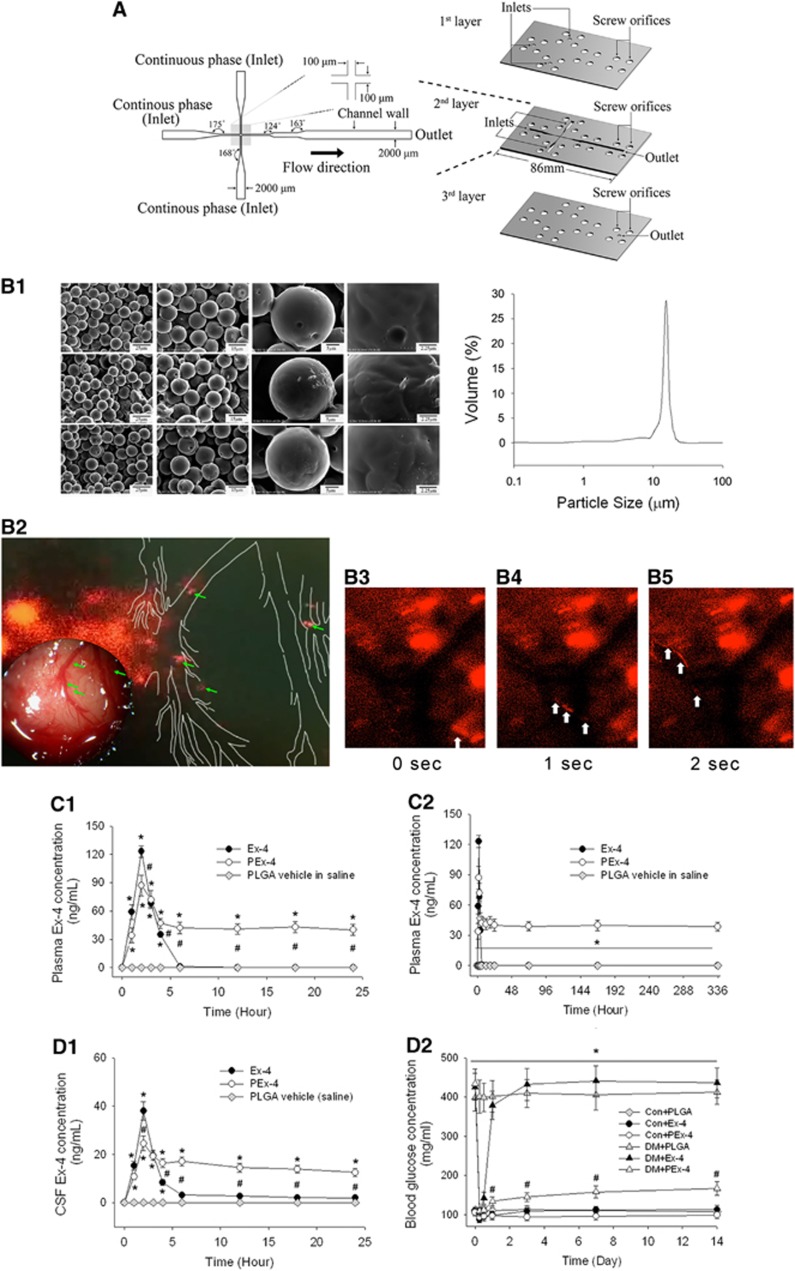Figure 1.
Exendin-4 (Ex-4)-loaded poly(D,L-lactide-co-glycolide) (PLGA) microspheres (PEx-4) preparation. (A) An expanded view of the phenol formaldehyde resin-based microfluidic device, showing the geometry of the microfluidic channel and chip. (B) The prepared microspheres containing Ex-4 (PEx-4) were examined under a scanning electron microscope. The PEx-4 microspheres were uniform in size (15.0±3.3 μm) and morphology, and their distribution was analyzed by laser diffraction (B-1). After subcutaneous treatment, some of the PEx-4 microspheres were clogged into the brain (left site of red fluorescence, B-2) and some PEx-4 microspheres were degraded into small fragments (indicated by green arrow heads). We traced some degraded microspheres in the cortical microcirculation with white arrow heads within 3 seconds (B-3 to B-5). (C) (C-1) After subcutaneous administration of Ex-4 or PEx-4, both groups of rats (n=5 each) showed maximal plasma concentrations at 2 hours, but PLGA vehicle had no effect on Ex-4 concentration. The maximal plasma Ex-4 value 2 hours following Ex-4 administration was significantly higher (P=0.031) than that following PEx-4 treatment. (C-2) From 6 hours to 14 days, the plasma Ex-4 value of the PEx-4 group was significantly (P=0.001) higher than that of the Ex-4 group. (D) (D-1) The cerebrospinal fluid (CSF) Ex-4 concentration was directly associated with the plasma Ex-4. The maximal CSF Ex-4 value at 2 hours after Ex-4 treatment was significantly higher (P=0.024) than that after PEx-4 treatment. The CSF Ex-4 concentration of the PEx-4 group was significantly (P=0.016) higher than that of the Ex-4 group 6 to 24 hours after subcutaneous administration. (D-2) Hyperglycemic effects of subcutaneously administered Ex-4, PEx-4, or PLGA vehicle in control and diabetes mellitus (DM) rats (n=5 each). In normoglycemic control rats, subcutaneous Ex-4 (P=0.019) or PEx-4 (P=0.032) significantly decreased blood glucose to hypoglycemic levels after 6 hours of treatment, respectively, but PLGA vehicle microspheres did not (P=0.69). PEx-4 significantly (P=0.002 vs. Ex-4) depressed blood glucose levels from 12 hours to 14 days in DM rats, but Ex-4 had no effect on DM-induced hyperglycemia during this period. Group differences were compared by one-way analysis of variance, followed by Tukey's multiple comparison tests. P<0.05 indicates a significant difference. *Different from control (Con); #different from DM.

